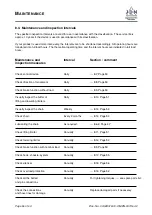
I
NITIAL OPERATION
to the first commissioning and after significant
changes before recommissioning.
Hoists built into trolleys must be tested by an ex-
pert.
The testing extends from the installation, outfitting
and operational ability under normal conditions,
mainly to check the completeness, suitability and
effectiveness of the safety equipment, as well as to
the state of the device, the lifting gear, the equip-
ment and the load-bearing medium.
Safety devices are:
•
Brake assemblies (
,
→
Section 5.5.3)
•
Lifting limiter (
,
→
Section 5.5.5)
•
Lowering limiter (
,
→
Section 5.5.6)
•
Overload protection (
,
→
Section 5.5.4)
5.5.1. Check control device
WARNING
Danger from faulty controller
A rough-running control element or a control el-
ement that is stuck in an actuated position may
indicate a faulty controller.
I
Do not use the product
I
Have the product repaired
1. Relieve the product
PROFI 25 TI
.
2. Briefly actuate and release all control ele-
ments of the controls one after the other. The
control elements must return to their initial po-
sitions immediately. The on and off function
must operate without problem.
All control elements of the controls must always be
free-moving.
5.5.2. Check direction of movement
I
Check that the direction of movement of the
load hook corresponds to the direction indi-
cated by the arrows on the control elements.
5.5.3. Check the braking function
WARNING
Danger from loads crashing
If the chain lags, it may be due to a faulty brake.
The load may fall.
I
Do not use product
I
Have the product repaired
Check without load
I
Alternatively switch your unloaded product
PROFI 25 TI
to lifting and lowering
If you release a control device, the chain must
come to a standstill in an acceptable time after
the brake has been applied. For physical reasons,
however, the braking distance cannot have the
value zero. The brake has a response time that is
dependent on the control length. A greater control
length increases this response time.
Doc.-No.: VA049318-10-OM-EN-0319-64-2
Page
31
of 64






































